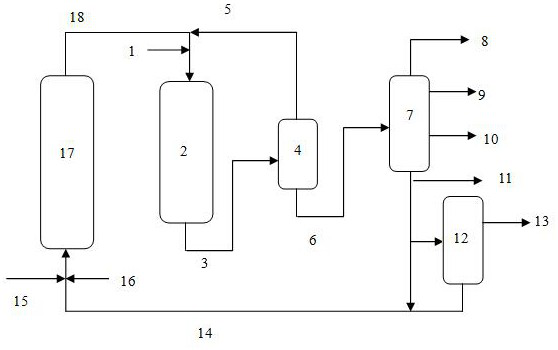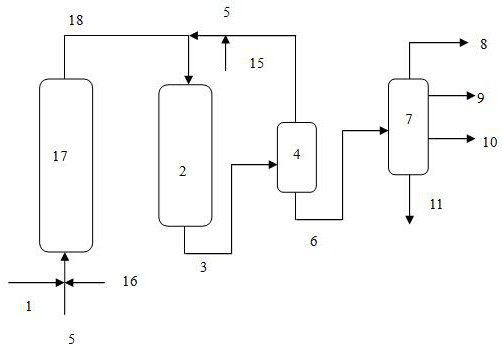Method for producing marine fuel oil through hydrogenation
A fuel oil and marine technology, which is applied in the field of flexible production of low-sulfur marine fuel oil, can solve the problems of increased difficulty in product blending, increased production cost, and increased conversion rate, and can improve metal-holding capacity, enhance adaptability, and prevent excessive heating. The effect of hydrogen conversion
- Summary
- Abstract
- Description
- Claims
- Application Information
AI Technical Summary
Problems solved by technology
Method used
Image
Examples
Embodiment 1
[0043] The fixed-bed reactor of the device adopts three sets in series, one of which is filled with two kinds of residual oil hydrogenation protection agents, and the filling volume is 30mL of FZC-12B catalyst and 50mL of FZC-103E catalyst; Catalyst, the loading volume is 50mL for FZC-28A catalyst and 180mL for FZC-204 catalyst; FZC-34A, a residual oil hydrodesulfurization catalyst, is loaded in the three reverse reactions, and the loading volume is 200mL. Catalyst properties are shown in Table 2.
[0044] The upflow reactor of the device adopts a reactor with two beds, of which the first bed is filled with FZC-10U upflow residual oil hydrodemetallation catalyst 120mL, and the second bed is filled with FZC-11U upflow residual oil demetallization catalyst. Hydrogen desulfurization catalyst 158mL. Catalyst properties are shown in Table 3.
[0045] After further hydrogenation treatment, fixed bed hydrogenation reaction produces oil. The main operating conditions are shown in T...
Embodiment 2
[0049] In addition, it can be seen that the up-flow hydrogenation reactor is used to treat the hydrogenated vacuum residue to make it deeply desulfurized. At the same time, the mass fraction of saturated components in the product is 57%~59%, and the aromatic content is about 30%. The content is 10%~11%. The sum of the two reaches 40%. The inventors found that the fixed-bed hydrogenation makes the sum of the aromatic components and gums in the oil saturated by hydrogenation less than 35%, which will affect the stability of the oil system. Therefore, the present invention can improve the stability of marine fuel oil under the condition of satisfying various product indexes.
[0050] Comparative example 1
This comparative example adopts the process route of upflow type and fixed bed reactor series (see figure 2 ), the residual oil raw material A with relatively good properties and the residual oil raw material B with relatively poor properties (see Table 1 for the properties...
Embodiment 3
PUM
 Login to View More
Login to View More Abstract
Description
Claims
Application Information
 Login to View More
Login to View More - R&D
- Intellectual Property
- Life Sciences
- Materials
- Tech Scout
- Unparalleled Data Quality
- Higher Quality Content
- 60% Fewer Hallucinations
Browse by: Latest US Patents, China's latest patents, Technical Efficacy Thesaurus, Application Domain, Technology Topic, Popular Technical Reports.
© 2025 PatSnap. All rights reserved.Legal|Privacy policy|Modern Slavery Act Transparency Statement|Sitemap|About US| Contact US: help@patsnap.com


